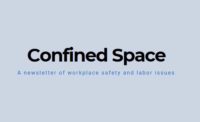A Confined Space blog post
Methylene chloride deaths: “all preventable”
Posted with permission from Confined Space, a newsletter of workplace safety and labor issues.
Methylene chloride kills. We wrote about 21-year old Kevin Hartley last June. He died last April 29 — Workers Memorial Day — while when he was overcome by methylene chloride while stripping a bath tub. Seventeen workers have died from over-exposure to methylene chloride between 2000 and 2015, and probably at least as many consumers.
“Methylene chloride is too dangerous to keep on the store shelves,” said Dr. Robert Harrison of the University of California San Francisco in a CBS interview (and video – below). Harrison works in occupational health. He says in a small room, just a half gallon’s worth of product containing that chemical can lead to a buildup of vapors that can prove lethal in less than an hour. “It’s immediately dangerous to life and health. It causes death,” Harrison said. Harrison says that all of those deaths were preventable.
Click here to view a video which also includes an interview with Hartley’s mother.
The EPA proposed last year to ban methylene chloride, as is the state of California, but the Halogenated Solvents Industry Association (HSIA) argues all that’s needed is a better label. But if people don’t read the label? Or don’t understand it? Or if you’re a day laborer trying to support your family, and your employer says “Hey, don’t worry. Get in there a do this. Or you’re fired!”
The HSIA representative says there is no information about whether people actually reads labels and doesn’t even know how you’d research that, although CBS uncovered an EPA study that says that multiple steps are required by the consumer to make labels effective. And the best way to protect people is to eliminate (or remove) the risk. Harrison confirms that “Most people don’t read the label,” which, according to the industry, makes these deaths the user’s fault. The European union, by the way, banned the use of methylene chloride in 2011.
HSIA issued an official response to the CBS report, basically reiterating that “Methylene chloride is an essential ingredient for removing paint and varnish and refinishing furniture,” alternatives aren’t as effective, existing OSHA and Consumer Product Safety Commission regulations work, and that all users “take appropriate safety precautions. “Methylene chloride should always be used in accordance with manufacturers’ labels.” HSIA is recommending an improved label, with a bathtub with a line crossed through it. (see right)
The HSIA instructions also warn workers to “Use respiratory protection when vapor concentrations may exceed OSHA limits, and pay particular attention to working in a closed environment.” This assumes that workers know, and can measure, the OSHA limit, and that they know what respirator to wear.
OSHA’s short term exposure limit to methylene chloride, by the way, is 125 parts per million, as measured over a 15-minute period. Respirators are only to be used if engineering controls (like ventilation) are inadequate, and paper masks or even cartridge masks are not adequate. Depending on the exposure level, some kind of supplied air respirator is needed — which means a whole face respirator with a hose supplying air, or a self-contained-breathing-apparatus (SCBA) like SCUBA divers wear. But of course, supplied air respirators are much more expensive than cartridge respirators, so contractors often don’t purchase them.
Hartley was using a respirator when he died — but only an inadequate (and illegal) two-cartridge mask. And by the time you start feeling the effect of the chemical, it may be too late.
And, of course, even if you get out of the bathroom alive, methylene chloride has been proven to cause cancer.
Click here to visit Confined Space.
Looking for a reprint of this article?
From high-res PDFs to custom plaques, order your copy today!






